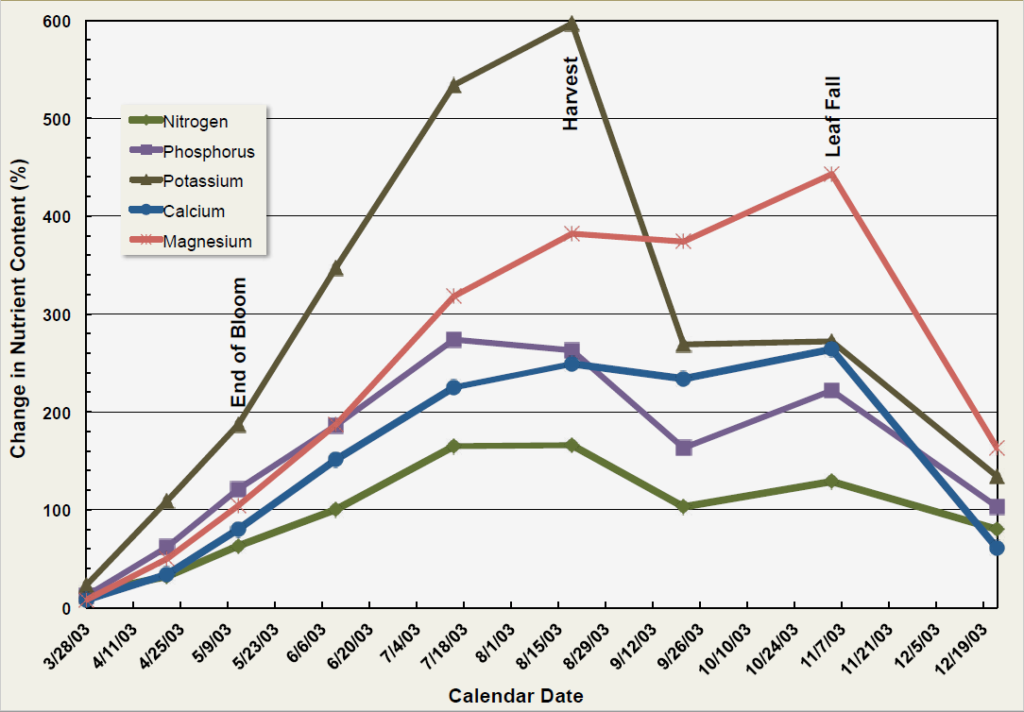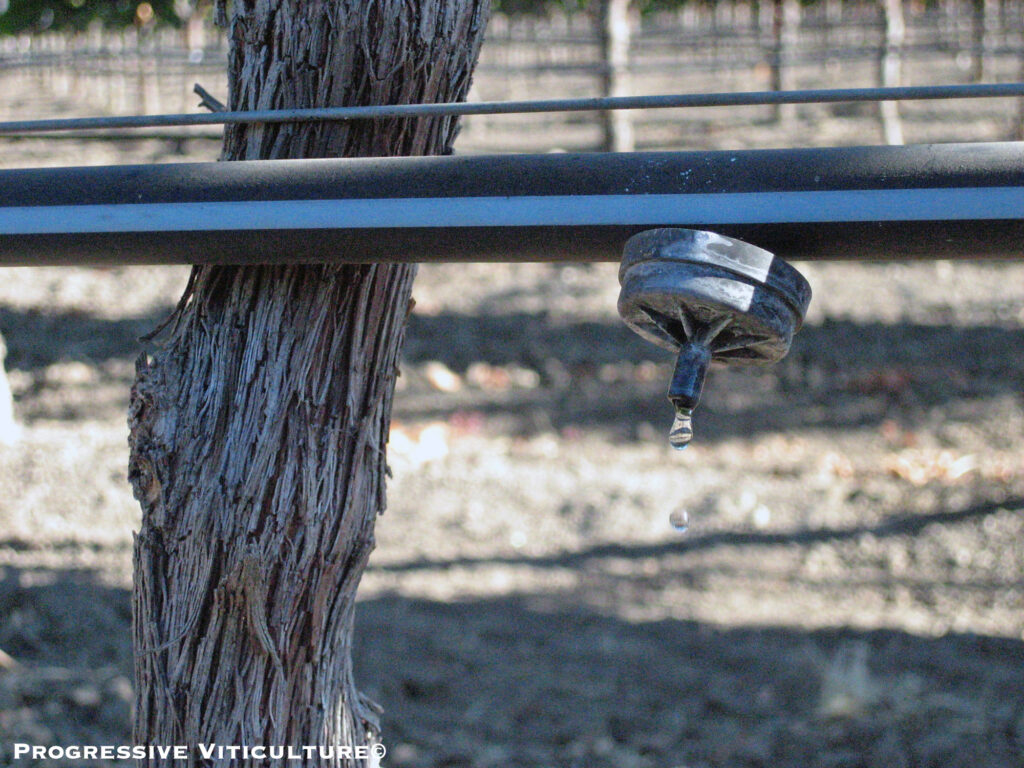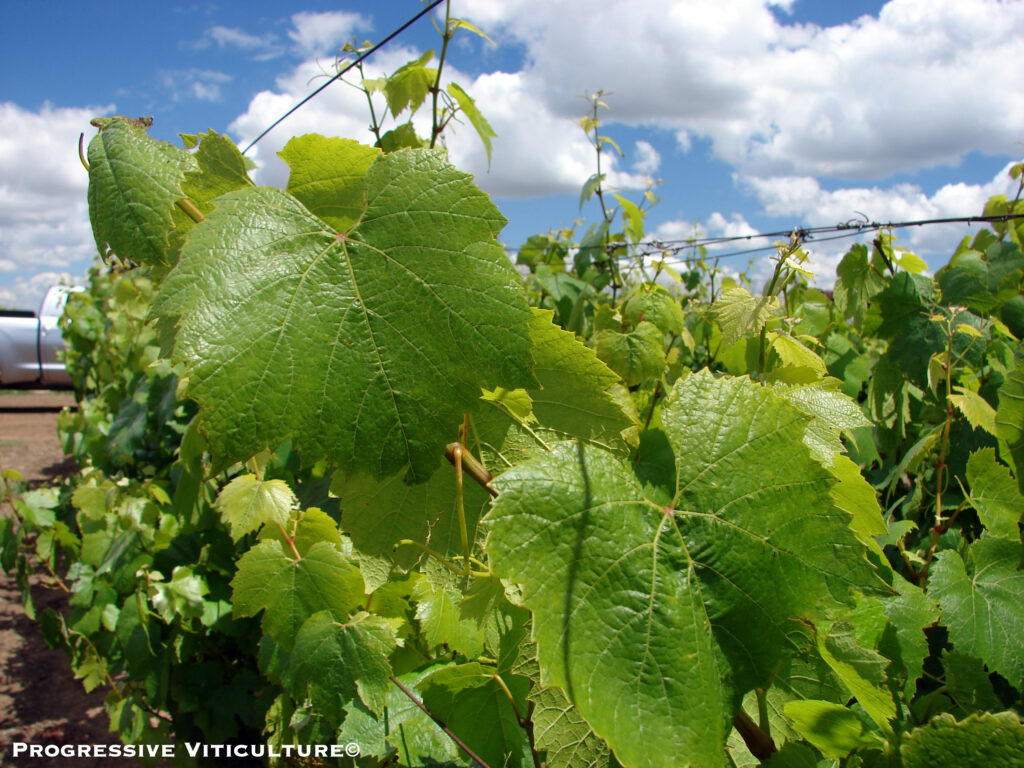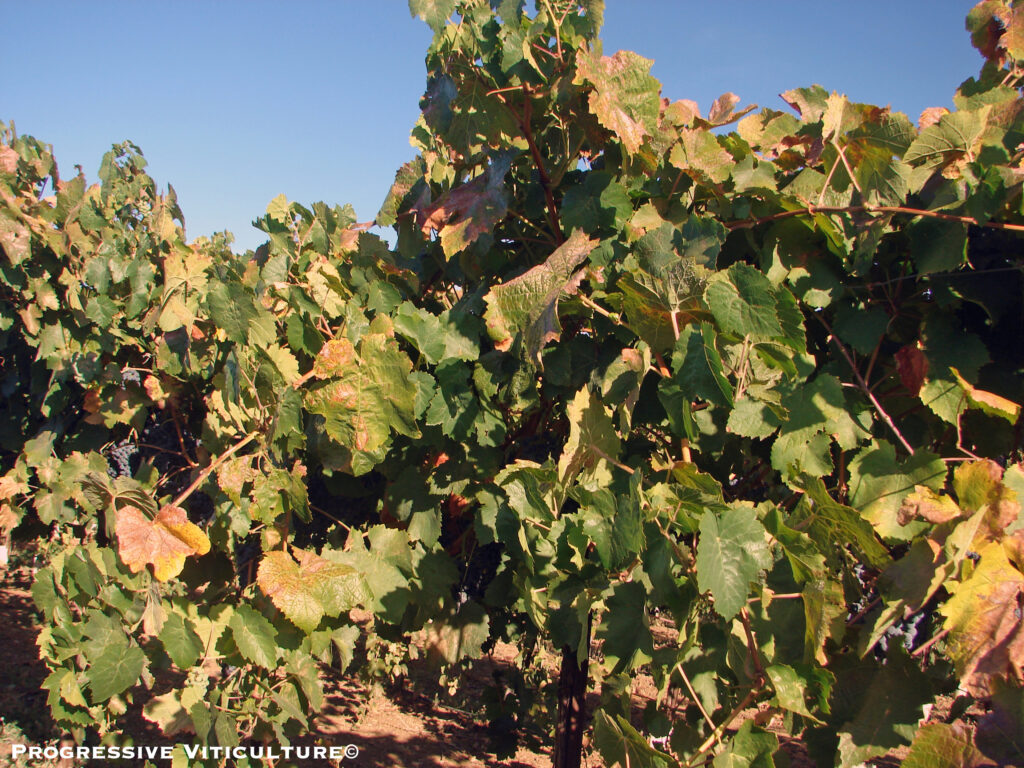MONDAY, MAY 24, 2021. BY STAN GRANT, VITICULTURIST.
Growing seasons have a rhythm-based on grapevine growth and development. Those of us in the winegrape business are well aware of this cadence because our work lives are tied to it.
Much less obvious is the seasonality of the vineyard mineral nutrient economy because it is mostly invisible, occurring below ground and within the vines. Still, we need to be in step with it if we hope to optimize the health and performance of our vineyards, and the value of applied mineral nutrient resources.
In this article, we will consider the seasonality of vineyard mineral nutrition and nutrient management activities with these goals in mind. Our focus will be macronutrients, which are the mineral nutrients required in comparatively large quantities in grapevines. They include nitrogen, phosphorus, sulfur, potassium, magnesium, and calcium.
The Seasonality of Vineyard Mineral Nutrient Demand
Here is an abridged version of the time sequence in vineyard mineral nutrient demand. Shortly before budbreak, grapevines begin to remobilize mineral nutrients stored in woody tissues and translocate them to developing buds and roots. After shoots have emerged, vine dependency on reserves wanes as leaves unfold and transpire, drawing water and mineral nutrients from the soil. At the same time, mineral nutrient demand in all growing tissues increases (Figure 1).
After the fruit sets and swells, the demand for nutrients continues to increase, but more for some than others. Potassium is prominent among them (Figure 1).

Figure 1. Seasonal demand for nitrogen, phosphorus, potassium, magnesium, and calcium in grapevines. (Data Source: Conradie, 1980 and Conradie, 1981)
Demand for some nutrients flattens as tissues age during ripening but increases again after harvest as nutrients are stored in woody vine tissues for use next year. There also are short-lived spikes in the demand for certain nutrients during the transitional developmental stages of bloom and veraison.
The Seasonality of Environmental Factors Impacting Mineral Nutrient Access
Very early in the growing season, vineyard soils are cool and at times overly wet, which inhibits root activities. Under such conditions, mineral nutrient demand sometimes exceeds nutrient uptake from the soil. Consequently, shoot and root growth become restricted to some degree. After soils warm and drain nutrient mining proceeds to the extent vine root systems allow. Later, as the bulk of the vineyard soil dries, root activity recedes into the small zones of moist soil under drip emitters and along with it, root access to soil nutrients. Simultaneously, the concentration of root activity in drip zones enhances the efficiency of mid and late season fertigations (Figure 2).

Figure 2. Fertilizer application through drip irrigation (fertigation) Is especially efficient mid to late season after soil moisture from winter rain is exhausted and the active root zone recedes under drip emitters. (Photo Source: Progressive Viticulture©)
Warm, moist soils favor the activities of soil microbes. Such activity includes the decomposition of labile soil organic matter and the release of the mineral nutrients it contains. The products of organic matter decomposition, in turn, enhance the very slow disintegration of mineral particles and the release of the nutrients within them. Under these same conditions, added organic amendments decompose and soil-applied dry fertilizers dissolve. Consequently, the early season, while vineyard soils are moist from winter rains and sufficiently warm, is when soil nutrients are most abundant. As mentioned above, this period coincides with the period of the rapid shoot and root growth.
Monitoring Mineral Nutrients Through the Growing Season
Vineyard monitoring for mineral nutrients also has a seasonal pattern. Early in the growing season, foliage color and the rate of canopy development are useful indicators of nutrient need (Figure 3). As veraison approaches, the onset of fruit and wood ripening can serve as nutritional indicators. All through the year, distinctive leaf symptoms reveal nutrient deficiencies. Bloom and veraison tissue analysis results provide detailed snapshots of vine nutrient status, while post-harvest analysis of soils in the vine row points towards the cumulative effects of the season’s fertigations on the nutrient supply.

Figure 3. Early in the growing season, a slow-growing, pale canopy is an indicator of a nitrogen need in grapevines. (Photo Source: Progressive Viticulture©)
Fertilizing In Sync with Vines – General Considerations
Equipped with the information and concepts stated above, we can design mineral nutrient management plans synchronized with vine need and vineyard conditions. Current fertigation technologies make such plans feasible because they allow us to place readily available nutrients during specific times of need where vines can access them and when roots are capable of taking them up. Further, where root zone conditions are unfavorable or when there is a transient spike in nutrient demand in developing shoots, such as during bloom, foliar fertilization is a viable alternative to fertigation.
Even for well-managed vineyards, where vines have full stores of mineral nutrient reserves in woody tissues and soils are fertile, targeted fertigations to elicit specific vine responses at specific times are beneficial. While this is true at any time, such fertigations are especially effective mid-season after root activity has receded under drip emitters. For vineyards on low fertility soils and/or with high mineral nutrient requirements, the seasonal fertilizer nutrient allocation guidelines and the targeted values to satisfy mineral nutrient demand in ripe fruit presented in (Table 1) can be useful.
Fertilizing In Sync with Vines – Specifics
After budbreak, fertilizers containing a small quantity of nitrogen as ammonium and an abundance of phosphorus favor root growth and function. In fact, these nutrients are present in a few fertilizers specifically designed to stimulate roots through fertigation. Foundation MVR, PRG, Structure, and Rootex are among such fertilizers. Small amounts of organic acids and one or more micronutrients are commonly present in them.
Early in the growing season, applied calcium is also beneficial for elongating roots, as well as for the integrity of growing shoot tissues. Should early season shoot growth proceed too slowly, apply nitrate to accelerate it. Nitrate fertilizer will not be effective, however, if vines are lacking manganese or boron, which are nitrate metabolism cofactors. During the same time period, deficiencies of magnesium, sulfur, and certain micronutrients (iron, manganese, and copper) limit photosynthesis and growth. Fortunately, fertilizers containing highly available forms of these nutrients applied through fertigation and foliar fertilization easily correct these deficiencies.
Immediately before or during the first traces of bloom, modern foliar fertilizer technologies are valuable for satisfying the very high transient nutrient demand for pollen formation, pollination, and fruit set. Nutrients of concern include phosphorus and micronutrients boron, zinc, and molybdenum.
Following fruit set, fertigation with nitrate and potassium promote fruit development. Applied manganese, iron, copper, and boron assure normal development of phenolic compounds, as well as efficient nitrogen metabolism. Foliar applied urea can ensure adequate yeast assimilable nitrogen (YAN) in fruit.
During ripening, a small quantity of calcium nitrate will diminish stress and refresh aging leaves. At the same time, a low rate of soluble potassium will promote sugar accumulation in berries. Late in the ripening period, N-P-K fertilizers low ammonium nitrogen and high in phosphorus and potassium can stimulate roots to produce and translocate hormones that inhibit premature foliage aging (Figure 4).
After harvest, fertigation with calcium nitrate remains stimulatory to leaf function, while advancing nutrient storage in woody vine tissues. During the same time, a small amount of ammonium and a liberal dose of phosphorus and potassium promote a flush of root growth, as well as mineral nutrient storage. Where irrigation water is scarce, foliar-applied urea, potassium nitrate, and mono-potassium phosphate can meet part or all post-harvest nutrient needs.
Conclusions
As with all aspects of vineyard management, timing and consistency in fertilization are essential for optimized vineyard performance and return on investment. Fortunately, we have the knowledge to guide us through each growing season and the technologies to consistently meet vine mineral nutrient requirements in a timely manner.
A version of this article was originally published in the Mid Valley Agricultural Services March 2016 newsletter and was updated for this blog post.
Further Reading
Bolton, S, and Grant, S. Ripening period potassium deficiency. Lodi Winegrape Commission Coffee Shop. (lodigrowers.com). September 17, 2018.
Burt, C, O’Connor, K, and Ruehr, T. Fertigation. Irrigation Training and Research Center, Calif. Poly. State Univ., San Luis Obispo, CA. 1998.
Conradie, W. J. Seasonal uptake of nutrients by Chenin blanc in sand culture: I. Nitrogen. S. Afr. J. Enol. Vitic. 1, 59-65. 1980.
Conradie, W. J. Seasonal uptake of nutrients by Chenin blanc in sand culture: II. Phosphorus, potassium, calcium, and magnesium. S. Afr. J. Enol. Vitic. 2, 7-13. 1981.
Grant, S. Nitrogen Fertilizer Forms. Lodi Winegrape Commission Coffee Shop. (lodigrowers.com). January 4, 2017.
Grant, S. Considering mineral nutrient interactions. Wines and Vines. pp. 46-47. March, 2016.
Grant, S. Micronutrient management in vineyards. Lodi Winegrape Commission Coffee Shop. (lodigrowers.com). December 16, 2015.
Grant, S. Nitrogen Part I. The pivotal grapevine nutrient. Lodi Winegrape Commission Coffee Shop. (lodigrowers.com). November 17, 2015.
Grant, S. Nitrogen Part II. Effective Nitrogen Management in Wine Grape Vineyards. Lodi Winegrape Commission Coffee Shop. (lodigrowers.com). November 24, 2015.
Grant, S. Managing vineyard mineral nutrient efficiency beyond the 4 R’s. Lodi Winegrape Commission Coffee Shop. (lodigrowers.com). September 29, 2015.
Grant, S. Balanced soil fertility management in vineyards. Practical Winery and Vineyard. May/June 2002.
Grant, S. Fertilizer efficiency for wine grape vineyards. Practical Winery and Vineyard 28. March/April 2006.
Grant, S. Managing phosphorus deficiency in vineyards. Practical Winery and Vineyard. 14(6): 87-90. January/February 1998.
Keller, M. Deficit irrigation and vine nutrition. Am. J. Enol. Vitic. 56, 267-382. 2005.
Keller, M. The science of grapevines. Academic Press, Burlington, MA. 2010.
Marschner, H. Mineral nutrition of higher plants. 2nd Ed. Academic Press, London. 1995.
Mullins, M. G., A. Bouquet, and L. E. Williams. Biology of the grapevine. Cambridge University Press, Cambridge. 1992.
Tisdale, SL, Nelson, WL, and Beaton, JD. Soil fertility and fertilizers. 4th Ed. Macmillan Publishing Company, New York. 1985.
Have something interesting to say? Consider writing a guest blog article!
To subscribe to the Coffee Shop Blog, send an email to stephanie@lodiwine.com with the subject “blog subscribe.”
To join the Lodi Growers email list, send an email to stephanie@lodiwine.com with the subject “grower email subscribe.”
To receive Lodi Grower news and event promotions by mail, send your contact information to stephanie@lodiwine.com or call 209.367.4727.
For more information on the wines of Lodi, visit the Lodi Winegrape Commission’s consumer website, lodiwine.com.
For more information on the LODI RULES Sustainable Winegrowing Program, visit lodigrowers.com/standards or lodirules.org.




